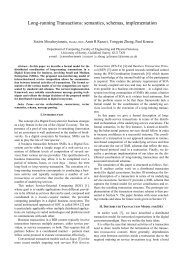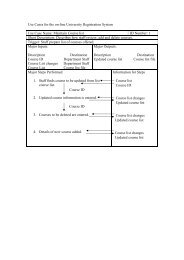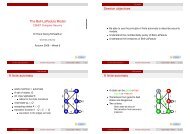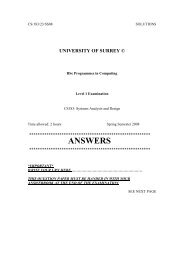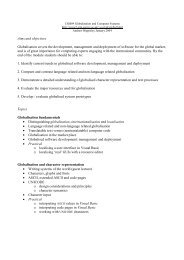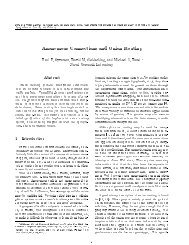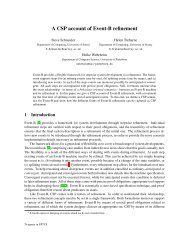Corpus-Based Thesaurus Construction for Image Retrieval in ...
Corpus-Based Thesaurus Construction for Image Retrieval in ...
Corpus-Based Thesaurus Construction for Image Retrieval in ...
You also want an ePaper? Increase the reach of your titles
YUMPU automatically turns print PDFs into web optimized ePapers that Google loves.
mean<strong>in</strong>g. A range of semantic relations may exist between these different lexicalunits. [25] presents a model that illustrates some basic relationships between classesof entities: Identity, where class X and class Y have exactly the same members. Thelexical relation which corresponds to this is synonymy, <strong>for</strong> example “f<strong>in</strong>gerpr<strong>in</strong>t” and“lift” are synonyms <strong>in</strong> that they are syntactically equal; Inclusion, where class Y isentirely <strong>in</strong>cluded with<strong>in</strong> class X. The lexical relation correspond<strong>in</strong>g to this ishyponymy, which is most commonly illustrated by the construct ‘Y is a k<strong>in</strong>d/type ofX.’ An example of this could be ‘a gun is a type of firearm’. The most common typeof lexical hierarchy is a taxonomy, which reflects the hyponymy relationship alsoknown as the supertype/subtype or subsumption relationship and a meronomy, whichmodels the part-whole relationship. This section attempts to discover frequentlyoccurr<strong>in</strong>g patterns that demonstrate these two types of relationships.Phrasal structures such as compound words convey a certa<strong>in</strong> semantic relationshipbetween the constituent lexical units. Usually headwords such as scene are weaksemantically <strong>in</strong> that their mean<strong>in</strong>g cannot be easily ascerta<strong>in</strong>ed out of context unlessthey are part of a compound, <strong>for</strong> example crime scene or movie scene specify whattype of scene it is. Compound<strong>in</strong>g tends to specialize the mean<strong>in</strong>g of the headword,which can be used to create a hierarchy. For example tak<strong>in</strong>g the three compoundsblood sample, f<strong>in</strong>gerpr<strong>in</strong>t sample and DNA sample, it shows that blood, dna andf<strong>in</strong>gerpr<strong>in</strong>t are different types of samples. Similarly there may be certa<strong>in</strong> lexical cuessuch as k<strong>in</strong>d of and part of, which convey hyponymic or meronymic relationshipsbetween certa<strong>in</strong> lexical units they are syntactically associated with. In the follow<strong>in</strong>gwe discuss the possible elicitation of conceptual structures from texts, which can beused to def<strong>in</strong>e broader and narrower terms <strong>in</strong> the thesaurus.The hypernymy/hyponymy relationship, also known as the supertype/subtype orsubsumption relationship, is the semantic relationship that is used to build taxonomies<strong>for</strong> various purposes –a classic example be<strong>in</strong>g the biological classification of species.At the higher levels of a taxonomy more general/broader concepts are encountered,<strong>for</strong> example knife is a general concept <strong>for</strong> a dagger or stiletto. There are a number ofl<strong>in</strong>guistic patterns that can be used to illustrate the hyponymic relationship <strong>in</strong> texts.The cues is a, or is a type of are the most common patterns but there are a number ofothers that are typically associated with this relationship.There are certa<strong>in</strong> enumerative cues [22] that can be used to derive hyponymicrelationships as well. For example tak<strong>in</strong>g the sentence “All automatic weapons suchas mach<strong>in</strong>e guns must be registered” one can derive hyponym (‘mach<strong>in</strong>e gun’,‘automatic weapon’). Typical hyponymic and enumerative cues listed <strong>in</strong> the literatureon lexical semantic analysis <strong>in</strong>clude:Table 6. List of hyponymic and enumerative cuesHyponymic CuesEnumerative Cuesis a; k<strong>in</strong>d of; type of; set of; class of; belongs tolike; such as; such * as; or/and other; <strong>in</strong>clud<strong>in</strong>g; especially.The aim was to study the patterns <strong>in</strong> which these cues occur as well as f<strong>in</strong>d out theproportion of valid phrases returned (i.e. those that depict a hypernym/hyponymrelationship or a meronymy/homonymy relationship). The cue or other was the mostproductive with 80% of the elicited phrases be<strong>in</strong>g valid. The cue belongs to picked up



